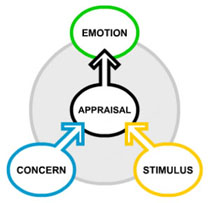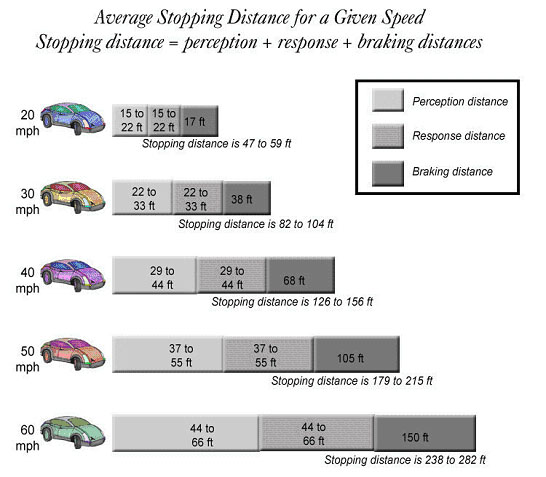
|
CLICK HERE TO START THIS COURSE AND GET THE CERTIFICATE OF COMPLETION |

Chapter
6
Time requirement of chapter: 30 minutes
DRIVING RISK CONTROL
In Chapter 6, participants will become familiar with the importance of recognizing and controlling driver and traffic risks. Chapter 6 will introduce participants to the ways emotions can affect a driver. Information on passing, railroads and following distance will also be addressed.
To read video transcript CLICK HERE |
|
||||||||||||||||||||||||||||||||||||||||||||||||||||||||||||||||||||||||||||||||||||
Emotions:
Emotions are strong positive and negative feelings. Emotions are the attitudes we have about life situations. Emotions tend to interfere with our ability to think clearly. Emotions create mental distractions. They create inattentiveness and increase the risks we are willing to take. Emotions cause us to lose concentration on the current task. Emotions cause an increase in our heartbeat. A persons breathing quickens and their digestion slows down. Usually our palms sweat and the body releases adrenaline. After long periods of emotional upset, people will even feel exhausted.
|
Letting our emotions control us can cause anger, anxiety, fear, hate and grief. Our need to satisfy our emotions while driving many times causes us to drive in a negative manner. We may speed even though we are in no particular hurry, just because everyone is passing us. If someone does something negative to us our emotional response may be to get even, and cause us to drive aggressively. We may become angry, anxious, fearful, frustrated, stressed or vengeful. The first and best method to control our emotions is to maintain a positive attitude. By understanding our emotional make-up we may be able to understand our feelings and control them. We may also identify driving situations that cause emotional stress and try to avoid times and locations where the situations occur. By understanding that most drivers are not out trying to get us mad we can reduce the emotional effects of their actions, intentional or otherwise. Realizing most drivers make mistakes, just like you and I, and that we are under the same stresses can help maintain a positive attitude. |
 |
Resources:http://www.dmv.org/how-to-guides/driving-and-emotions.php, http://www.surak.org/emotions.shtml, http://www.selfgrowth.com/articles/The_Effects_of_Emotions_on_Wellness.html
Keeping a Positive Attitude:
Attitude is the way a person thinks about somebody or something and the way they behave toward someone. It is their personal view or opinion of something. It also describes their general emotional approach to any person or situation.
Having a negative attitude will normally result in negative behavior while having a positive attitude might change a negative situation into a positive one or at least one that does not result in any negative consequences.
If a driver has a negative attitude about driving situations that may arise while driving these negative attitudes may lead to aggression, anger, and frustration.
 |
Below are some common negative attitudes many drivers have while driving:
|
These are all examples of negative driving attitudes. None of them of course are true and may lead to negative driving behaviors which may result in negative consequences.
Depending on the driving situation a driver may become more aggressive. They may have delayed reactions and misinterpret driving events. They may be focusing their attention more on their current attitude than on the driving task and miss potential and immediate hazards. Their attitude may cause them to take risks that they might not normally consider. If we are honest, most of us as drivers drive more with our attitudes than with our intellect.
Resources:http://www.about-personal-growth.com/attitude.html, http://changing-personal-habits.suite101.com/article.cfm/the_power_of_positive_attitude, http://www.saferoads.com/drivers/tips_attitude.html, http://www.tash.org/mdnewdirections/choice.htm, http://personaldevelopment.suite101.com/article.cfm/what_is_choice, http://www.eruptingmind.com/what-is-responsibility, http://www.coping.org/growth/accept.htm, Florida State Statute: 316.183
Passing:
Before deciding to pass another vehicle, a driver should first ask themselves why they are passing. In the majority of cases, passing is not justified. Either the pass will require traveling above the posted speed limit or will violate other passing laws. Many times a driver desires to pass just because the vehicle ahead is traveling the posted speed limit.
|
Once a decision is made to pass and the pass can be made safely and legally, the first step is to maintain the proper following distance. This allows for good visibility ahead to see if there are any approaching vehicles or other hazards. Next, the driver should engage the vehicle’s left turn signal or use the appropriate hand signal. After engaging the turn signal, the driver should check the vehicle’s mirrors and also turn their head to check the area of the vehicle’s blind spot. After checking the blind spot and determining there are no other vehicles passing or in the lane of travel, they should enter into the opposing lane and accelerate to the posted speed limit. A driver may want to warn the other driver of the intended pass by tapping the vehicle’s horn once. Drivers should always anticipate the possibility of another vehicle entering their path from side roads or driveways and be prepared to take evasive action. |
 |
Once the pass has been safely made the driver should engage the vehicle’s right turn signal, turn their head to check to make sure another vehicle did not also pass and cut into the lane ahead of them, and check their vehicles blind spot. When the driver can see the roadway in front of the vehicle they passed, they can safely pull back into the original lane of travel. Florida law requires passing vehicles to enter back into the right lane of travel before coming within 200 feet of any vehicle coming from the opposite direction. Once back in the lane of travel, they should make sure to turn off the right turn signal.
Passing on the right is legal only when there are two or more lanes of traffic moving in the same direction or the vehicle you are passing is making a left turn. Pulling off the pavement to pass on the right is against the law.
It is illegal to pass when there are double yellow lines, or a yellow line on your side of the travel lane. It is also illegal to pass when approaching hills, intersections, hospitals, schools, construction zones, before curves in the roadways, or within 100 feet of a bridge, viaduct, tunnel, or railroad crossing. It is a violation of law to pass in any area posted with no passing signs.
By regularly checking the side and rear-view mirrors, a driver can ensure there are no passing vehicles. If a driver is being passed, they should never speed up so the passing vehicle has to accelerate to make the pass possible.
They should move to the right side of their lane which will give the other vehicle’s driver more room and a better view of the road ahead. When making any left turn it is important to check to make sure that you are not being passed by another vehicle. Even if the other vehicle is making an illegal pass, by failing to check, you could be held partially responsible in the collision.
Resources: Florida State Statutes, 316.081, 316.082, 316.083,
316.085, 316. 087 and 316.0875, http://driversed.com/teen-drivers-education/passing.aspx
Railroads:
An average freight train traveling at 55 mph needs a stopping distance of more than a mile. Longer trains moving at faster speeds can take one and a half miles or more to stop. In a collision between a train and an automobile, the automobile and its occupants are usually the losers.
Florida law states any person walking or driving a vehicle and approaching a railroad grade crossing shall stop not less than fifteen feet nor more than fifty feet from the nearest rail of the railroad grade crossing and shall not proceed until the railroad grade can be crossed safely.
|
In the event the driver would not have a reasonable view of an approaching train they should stop before proceeding across the railroad grade crossing at the point nearest such crossing where the driver has a reasonable view of approaching train(s) and not proceed until the railroad grade can be crossed safely. A person walking or driving a vehicle shall stop if there is a clearly visible electric or mechanical device that is activated, a crossing gate is lowered, or there is a human flagger giving signal of an approaching train. A stop shall also be made if there is an approaching train emitting an audible signal or if the train by reason of its speed or nearness to the crossing is an immediate hazard. No person shall drive any vehicle through, around, or under any crossing gate or barrier at a railroad crossing while such gate or barrier is closed or is being opened or closed, nor shall any pedestrian pass through, around, over, or under any crossing gate or barrier at a railroad grade crossing while such gate or barrier is closed or is being opened or closed. |
 |
Railroad cross-buck signs are found at most railroad crossings. If there is more than one track, the sign below the cross-buck will show the number of tracks at the crossing.
If there is more than one track, make sure all tracks are clear before crossing. In heavy traffic make sure there is room for your vehicle on the other side of the tracks before starting to cross.
Gates are used with flashing signals at some crossings. Stop when the lights begin to flash, and before the gate lowers across your side of the road. Do not move forward until the gates are raised and the lights stop flashing as there may be a train approaching on an adjacent track.
Do not get trapped on the tracks. Only proceed through a highway-rail grade crossing if you are sure you can completely clear the crossing without stopping. Remember, the train is three feet wider than the tracks on both sides.
If your vehicle stalls on a crossing, immediately get everyone out and far away from the tracks. Call your local law enforcement agency for assistance.
If your vehicle ever stalls on a track while a train’s coming, get out immediately and move quickly away from the tracks in the direction the train is coming from. If you run in the same direction the train is traveling, when the train hits your car you could be injured by flying debris.
Resources: http://www.oli.org/education_resources/safety_tips.htm,
Florida State Statute: 316.1575
Following Distance:
Some drivers believe if they do not speed up if they are being tailgated, they will be run over. NOT TRUE! Other drivers believe they will never get where they are going. If this statement was true the driver would live at the exact point where they made the statement for eternity. Some drivers actually believe if they slowdown in an attempt to encourage the tailgater to pass that they will be driving backwards. Of course, motion forward can never be motion in reverse no matter how slow the vehicle is moving forward. These are just your emotions.
Unsafe practices such as braking to force the tailgater to retreat or slowing down to “punish” the tailgater are sometimes practiced by aggrieved motorists and may lead to an escalation of road rage. Tapping the brake pedal (without braking) to illuminate the brake lights or displaying hazard lights to bring the tailgater’s attention to the fact that his or her driving is causing concern may also aggravate the situation.
The safest solution is to yield to the other driver. Slower traffic should move to the farthest right lane. If you cannot yield then leave more room in front of your vehicle to allow for safe stopping distances for you and the tailgater behind you. Try to encourage a tailgating driver to overtake if it is safe to do so. Slow slightly below the normal flow of traffic speed. This allows the tailgater more room to pass, and your slower speed makes it easier for him to do so.
It also allows more room in front of your vehicle to stop safely if required. If safe to do so, pull off the side of the road and let the tailgater pass. If a tailgater persists in following your vehicle, travel to the nearest law enforcement agency and request assistance in dealing with the tailgating driver.
Resources:www.querycat.com/faq/768bc629fc714c234ca84aa54825496, www.smartmotorist.com/traffic-and-safety-guidelines/maintain-a-safe-following-distance-the-3-second-rule.html
|
Stopping Distance: Total stopping distance includes perception time, reaction time and actual stopping distance. Perception time is the amount of time it takes for a driver to realize there is a need to react to a situation. Perception time can only be estimated as it is different for each incident depending on what the driver was doing before they realized there was a need to react. |
 |
Reaction time is the amount of time from the perception of an immediate hazard to the actual attempt to complete an evasive maneuver. Initial driver reaction time is on average approximately ¾ of a second.
The average human reaction time of ¾ of a second is based on a laboratory setting where the driver is prepared and waiting for the measurement of reaction time. In actual emergency driving situations, a driver’s actual reaction time may be more than ¾ of a second. Actual reaction time of an average driver is approximately 1.5 seconds during daylight and 2.5 seconds at night.
A vehicle traveling at 60 mph covers 88 feet per second. But stopping that vehicle takes over 4.5 seconds and covers a distance of 271 feet. Why? Because there’s more involved in braking than the actual time a vehicles brakes are applied to the wheels (called “effective braking”). In particular, “perception time” and “reaction time” add considerable distance to stopping your car.
Let’s say for instance the perception time is an average of 3/4 of a second. Then the reaction time is the 3/4 of a second. When you combine perception and reaction time, a full 132 feet will pass before a vehicle even begins to slow down from 60 mph. So from the time a driver perceives a braking situation until the time their vehicle comes to a complete stop, a total of 4.6 seconds elapses. During that time the vehicle travels a total of more than 270 feet. That’s almost the length of a football field. Of course, the faster a vehicle is traveling the more time and distance it will take to stop.
 |
There are other factors as well, such as road conditions. When there is adverse weather conditions braking distance grows exponentially. On wet pavement, total braking time increases from 4.6 seconds to 6.1 seconds, and total braking distance shoots up from 271 feet to 333 feet. The worse the weather conditions, the greater the time required. In snowy conditions, even with snow tires, total stopping time jumps to 10.6 seconds and 533 feet. As a basis of comparison, this is roughly the same distance as the same vehicle coming to a complete stop from 90 mph on dry pavement, an effective doubling of the braking distance. |
Resources: www.howtodothings.com/automotive/a3255-how-to-calculate-your-braking-distance.html, www.safespeed.org.uk/tailgate.htm, www.edmunds.com/ownership/driving/articles/438101/article.html
The chart below gives average stopping distances at different speeds.

The Three Second Rule:
Utilizing the 3 second rule is the best method for ensuring a safe following distance. Here is how to use the 3 second rule.
Choose a fixed object near or above the road ahead, like a sign, tree, or an overpass. As soon as the rear end of the vehicle ahead of you passes the fixed reference point, begin counting: one-thousand one, one-thousand two and one-thousand three.
When the front of your vehicle passes the reference point, stop counting. If you reached the reference point before you finished the three-second count, then you are following too close.
If you finish the count before you reach the reference point, you have established a following distance that is considered a safe following window.
Resources: www.smartmotorist.com/traffic-and-safety-guidelines/maintain-a-safe-following-distance-the-3-second-rule.html, www.edmunds.com/ownership/driving/articles/438101/article.html
The three-second rule is designed to be used during clear weather, level roadways, and when following cars and light trucks. When there are either poor environmental conditions or when following large vehicles or motorcycles or when towing a trailer, additional seconds are needed to provide an adequate space cushion.
The chart below gives some recommendations of the seconds needed to provide
a proper following distance.

Emergency Vehicles:
| Upon the approach of any emergency vehicle that has its vehicle emergency lights and siren activated a driver shall yield the right-of-way by immediately driving to a position parallel to (and as close as possible to) the nearest edge or curb of the highway clear of any intersection and remain there until the emergency vehicle has passed. |  |
Drivers are required to stay a minimum of 500 feet behind any fire equipment
vehicle displaying flashing warning lights and sounding a siren. Drivers should
remain at the side of the road until the all emergency vehicles have passed.
Even though the law only requires a driver to only maintain a distance of 500
feet from a fire apparatus it is a good idea to follow this rule for all emergency
vehicles.
Move Over Law:
 |
The Move Over Act requires a driver to “move over” or “slow down” when approaching an authorized emergency vehicle that is stopped on any roadway. The law requires a driver on an interstate highway or other highways with two or more lanes traveling in the direction of the emergency vehicle, to vacate the lane closest to the emergency vehicle, as soon as it is safe to do so or slow to a speed that is 20 mph below the posted speed limit. If the emergency vehicle is stopped on a two-lane roadway with their emergency lights activated a driver is required to slow to a speed that is 20 mph less than the posted speed limit when the posted speed limit is 25 miles per hour or greater, or travel at 5 mph when the posted speed limit is 20 mph or less. |
Emergency vehicles include wreckers and Road Ranger vehicles.
A violation of the “Move Over Act,” is a moving violation punishable by a $60 fine and three-points on the violators driving record.
Resources: Florida State Statutes: 316.126, 316.2025, 318.19.
The Florida Point System:
The Florida Point System is the mechanism the State uses to assess points to the driver's license record for individuals convicted of violating the state traffic laws. The point system shall have as its basic element a graduated scale of points assigning relative values to convictions of the following violations:
Resource: Florida State Statute: 322.27, 316.074, 316.075, 316.0741, 316.2065, 316.0775(2), 403.413(6)(b).
Driver's Licensing Actions:
Possessing a driver's license in Florida is a privilege and not a constitutional right. Once an individual earns the privilege to operate a motor vehicle they must remain a safe and courteous driver to continue to legally retain the privilege of possessing a driver's license.
Suspensions:
A suspension means the temporary withdrawal of a licensee's privilege to drive a motor vehicle until they meet the requirements of the suspension to re-instate their driver's license from the suspension.
An individual's driver's license may be suspended for the following reasons:
Length of suspension:
Resource: Florida State Statutes: 322.27, 322.28.
Revocations:
Revocation means the termination of a licensee's privilege to drive. Revocation periods range from 180 days to life. Note: Revocation periods may be shorter in cases of revocation due to medical conditions, often pending the medical condition being corrected to the satisfaction of the FL DHSMV.
An individual's driver's license may be revoked for the following reasons:
A court may also order that your license be revoked for certain other traffic offenses:
Resource: Florida State Statute: 322.26.
Cancellations:
An individual's driver's license may be cancelled for failure to comply with certain sections of the Florida Statutes. A cancellation is a removal of one's driving privilege until they meet the requirements of law. Two examples of why a driver's license might be cancelled are making a fraudulent driver's license application, or failure to complete any required course within 90 days when required to do so by the Florida Department of Highway Safety and Motor Vehicles.
Resource: Florida State Statute: 322.22.
CHAPTER 6 QUIZ
| Question 1 | Emotions can have no effect on our driving.
|
||||||||
| Question 2 | __________ is the way a person thinks about somebody or something
and the way they behave toward someone.
|
||||||||
| Question 3 | An average freight train traveling at _____ mph needs a stopping
distance of more than a mile.
|
|
CLICK HERE TO START THIS COURSE AND GET THE CERTIFICATE OF COMPLETION |